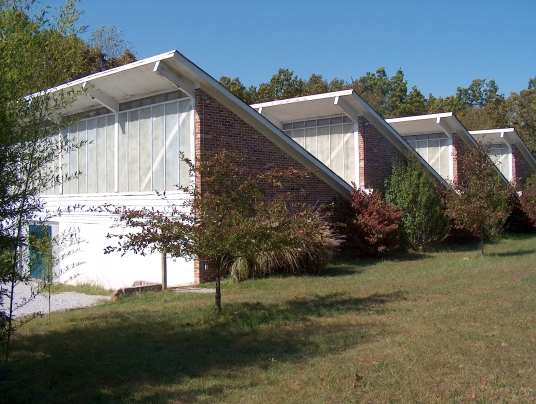Two words have come to represent the combined concepts of sustainability, human settlement and our relation to the earth: permaculture and ecovillages.
More than a collection of ideas, both words have developed criteria that can be identified to measure how a community such as The Farm fulfills the standards embodied by these two terms.

The passive solar school at The Farm Community.
Permaculture takes in design and planning that includes architectural engineering, food production, and structural organization modeled after natural ecosystems. Just as nature is able to continue in a revolving cycle of renewal, by emulating these patterns, new models of sustainability can be developed which emphasize the undeniable relationship between a healthy planet and healthy human existence.
Because The Farm was established decades before the term permaculture was created, its alignment with the outlook of permaculture was not the result of conscious planning, but came from an intuitive understanding of natural order. At the same time, members of the community were among the first to adopt the Permaculture school of thought, holding courses and offering internationally recognized certification in permaculture design.
Individual homesteads, neighborhoods and entire communities can benefit from the permaculture template. In this way The Farm makes an ideal subject that can be studied to examine ways in which it represents the design elements of permaculture, and areas where more could be done.
The Ecovillage Model
The word “ecovillage” implies a bond between people and nature, comprehending the unquestionable link between human settlements and the environment around them, going further to include the many layers of human relations. If anything, it is the disconnect from the natural world inherent in urban development that perpetuates the illusion that we are separate, isolated, and bear no responsibility to future generations.
If we are to turn this spaceship earth in a new trajectory, the inspiration will come not from corporations or governments or begin on a grand scale, but will be found in the myriad of experiments in community pointing the way. Ecovillages are like rhinestones, tiny jewels scattered across the wider fabric of society, reflecting back the light, catching our attention, a reminder that answers are often to be found in the smallest of things.
In addition to “ecology,” the “eco” in ecovillage represents “ecological.” The purpose of an ecovillage is to be a model of sustainable living, a way of life that is able to continue into the indefinite future because it fulfills the needs of the people who live there in a way that preserves, protects and even enhances its environment.
